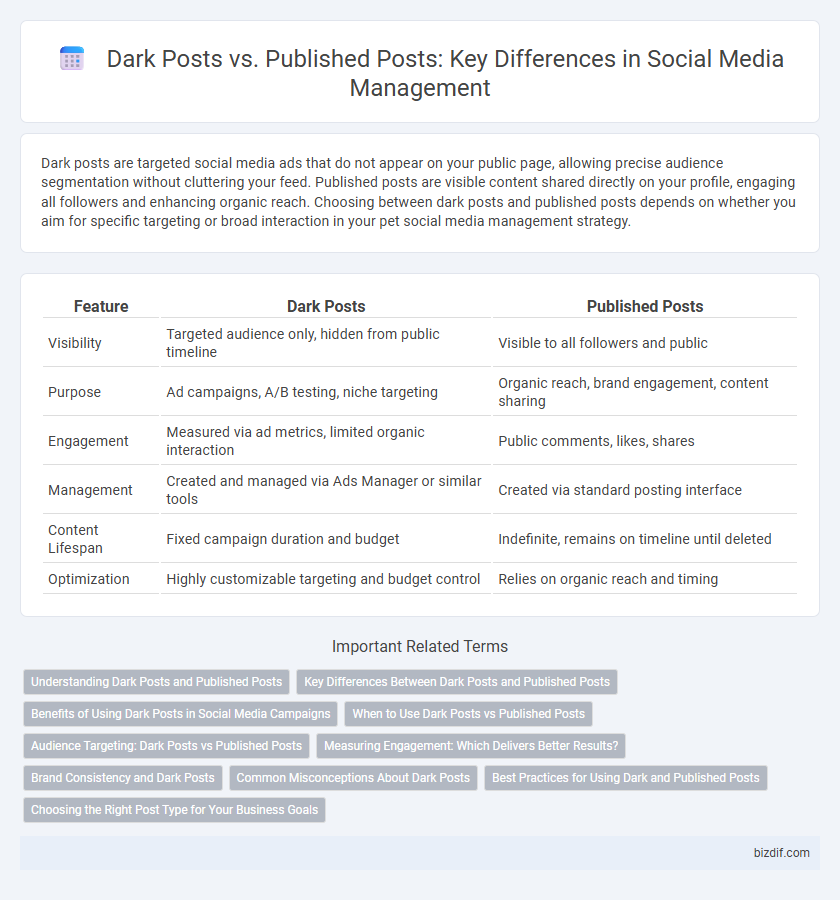Dark posts are targeted social media ads that do not appear on your public page, allowing precise audience segmentation without cluttering your feed. Published posts are visible content shared directly on your profile, engaging all followers and enhancing organic reach. Choosing between dark posts and published posts depends on whether you aim for specific targeting or broad interaction in your pet social media management strategy.
Table of Comparison
| Feature | Dark Posts | Published Posts |
|---|---|---|
| Visibility | Targeted audience only, hidden from public timeline | Visible to all followers and public |
| Purpose | Ad campaigns, A/B testing, niche targeting | Organic reach, brand engagement, content sharing |
| Engagement | Measured via ad metrics, limited organic interaction | Public comments, likes, shares |
| Management | Created and managed via Ads Manager or similar tools | Created via standard posting interface |
| Content Lifespan | Fixed campaign duration and budget | Indefinite, remains on timeline until deleted |
| Optimization | Highly customizable targeting and budget control | Relies on organic reach and timing |
Understanding Dark Posts and Published Posts
Dark posts refer to unpublished social media ads that target specific audiences without appearing on a brand's public timeline, allowing precise audience segmentation and testing without cluttering the main feed. Published posts are visible content shared on a brand's profile, designed to engage a broad audience and build organic reach through likes, comments, and shares. Understanding the strategic use of dark posts versus published posts enables marketers to optimize ad spend, tailor messaging, and maximize campaign effectiveness across platforms like Facebook and Instagram.
Key Differences Between Dark Posts and Published Posts
Dark posts are unpublished social media ads visible only to targeted audiences, enabling precise segmentation and A/B testing without cluttering the main feed. Published posts, in contrast, appear publicly on profiles, accessible to all followers and contributing to organic reach and engagement metrics. The key differences lie in visibility control, audience targeting, and impact on overall social media presence.
Benefits of Using Dark Posts in Social Media Campaigns
Dark posts enable precise audience targeting without cluttering your public timeline, allowing for tailored messaging to specific demographics. They offer valuable insights through A/B testing different content variations, optimizing campaign performance based on real-time analytics. By controlling post visibility, brands maintain a cohesive public image while maximizing engagement and conversion rates through personalized ads.
When to Use Dark Posts vs Published Posts
Dark posts are ideal for targeted advertising campaigns on social media, allowing precise audience segmentation without cluttering the brand's public feed. Published posts work best for organic engagement, fostering community interaction and building long-term brand presence. Choosing between dark posts and published posts depends on campaign goals, audience targeting needs, and desired visibility on the social platform.
Audience Targeting: Dark Posts vs Published Posts
Dark posts allow precise audience targeting by appearing only to selected users without public visibility, enhancing campaign customization and minimizing audience fatigue. Published posts are visible to an entire follower base, limiting targeting specificity but encouraging organic engagement and brand transparency. Effective social media management leverages dark posts for personalized ads and published posts for broad community interaction.
Measuring Engagement: Which Delivers Better Results?
Dark posts on social media enable targeted A/B testing, providing precise insights into audience engagement without affecting the public brand feed, while published posts accumulate organic interactions visible to all followers. Dark posts often yield higher click-through rates and conversion metrics due to tailored audience segmentation, whereas published posts drive broader brand awareness through shareable content. Measuring engagement requires comparing key performance indicators like reach, impressions, clicks, and interaction rates across both formats to determine which aligns best with specific campaign goals.
Brand Consistency and Dark Posts
Dark posts on social media allow brands to target specific audiences with tailored content without altering their public feed, maintaining overall brand consistency. Unlike published posts, which are visible to all followers and contribute to the brand's cohesive aesthetic, dark posts remain hidden from the main timeline. This strategy enables precise message customization while preserving a unified brand image across all channels.
Common Misconceptions About Dark Posts
Dark posts are often misunderstood as hidden or deceptive content, but they are actually unpublished ads targeted to specific audiences on social media platforms like Facebook and Instagram. Unlike published posts, dark posts do not appear on the brand's public timeline, preventing clutter and allowing for precise audience segmentation and testing. Marketers leverage dark posts to deliver tailored messages without overwhelming or confusing their broader follower base, optimizing engagement and ad performance.
Best Practices for Using Dark and Published Posts
Dark posts allow precise audience targeting without cluttering your public feed, making them ideal for A/B testing and promoting time-sensitive offers. Published posts build brand credibility and community engagement by being visible to all followers, enhancing organic reach and trust. Balancing both with clear objectives and consistent messaging ensures optimized ad spend and stronger overall social media presence.
Choosing the Right Post Type for Your Business Goals
Dark posts enable precise audience targeting without cluttering your main social media feed, making them ideal for testing campaigns and promoting time-sensitive offers. Published posts increase brand visibility and engagement by appearing on your profile, fostering long-term community growth. Selecting between dark posts and published posts depends on whether your priority is targeted conversions or broad organic reach aligned with business goals.
Dark posts vs Published posts Infographic

 bizdif.com
bizdif.com